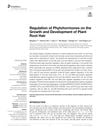Dual-Flow RootChip Reveals Local Adaptations of Roots Towards Environmental Asymmetry at the Physiological and Genetic Levels
November 2017
in “
New Phytologist
”
TLDR Roots adapt to uneven environments by changing growth and gene expression.
The study utilized the dual-flow-RootChip (dfRootChip) to explore how Arabidopsis roots adapt to asymmetric environmental conditions at both physiological and genetic levels. The dfRootChip allowed precise control of environmental conditions, revealing that root hair growth was inhibited on the side with low phosphate (Pi) availability and continued on the Pi-rich side, demonstrating cell-autonomous regulation. The expression of the RSL4 gene was higher on the Pi-rich side, indicating genetic adaptations to environmental asymmetry. The research highlighted the potential of microfluidic technology to study plant-environment interactions, providing insights into plant adaptation mechanisms.



